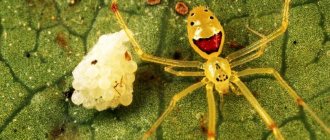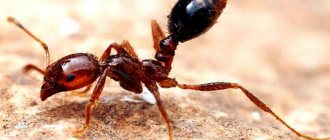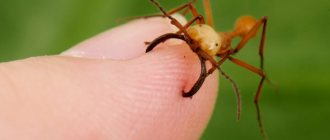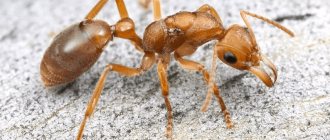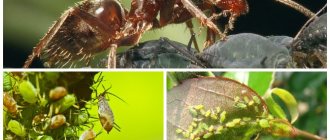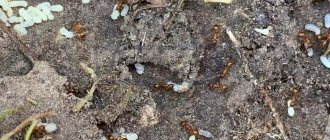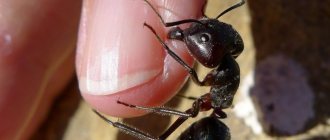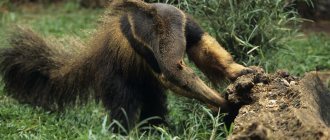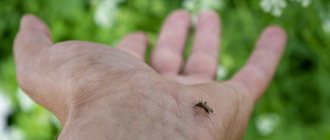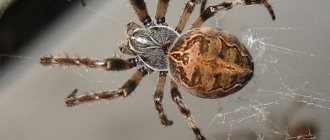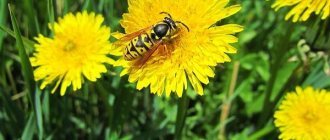Hierarchy
At the head of the anthill is usually the queen - this is a large insect that continuously lays eggs, ensuring the replenishment of the community with new residents. Worker ants perform daily tasks such as caring for eggs and pupae, searching for food, and repairing the anthill. Soldiers stand guard at the entrances to the home and cut off strangers. Males and females participate in the process of reproduction.
Soldiers
Warrior ants are a separate subspecies of simple workers , differing from the latter in being slightly larger in size. In addition, such an ant has more developed mandibles, the muscles of which occupy most of the head. In some species of ants, due to the characteristic structure of the head, soldiers have lost the ability to eat independently - as a result, workers have to feed them.
The main function of soldier ants in a community is to protect the territory and the anthill from the penetration of enemies, and to protect the foragers who deliver food. In addition, soldiers with their powerful jaws help to dismember the prey into several parts if the workers cannot carry it away on their own.
The role of the worker ant in the family and structural features
Builder ants are the first species to emerge from the queen after the founding of a new anthill. They are the ones who are involved in building the colony, preparing food and caring for eggs and pupae. In a developed anthill, workers have a predominant number among all individuals.
REFERENCE! The distribution of professions among ant workers depends on their general condition and mental inclinations.
Thus, proactive insects with good reactions become scouts and hunters, and slow and leisurely individuals go to graze aphids and collect sweetish secretions. In addition, a change of profession occurs as one ages.
Young individuals usually perform work inside the nest - they take care of eggs , females, and build new passages and chambers.
If a significant part of the workers of one profession dies - for example, they are destroyed by birds or as a result of chemical treatment, their responsibilities are redistributed among the remaining inhabitants of the anthill.
How does an anthill work inside, what is its structure?
Sectional diagram of the structure of an anthill with the designation of functional chambers.
Structure of an ant colony. Most often, dome-shaped anthills are found, but sometimes ants prefer to settle in rotten tree trunks or large old stumps. In regions with extremely hot climates (for example, deserts), insects build their homes exclusively underground.
The inside of an anthill looks different, but the structure of the allocation and organization of specialized chambers is characteristic of any nest of ants.
Indoor cameras can be divided into the following categories:
- “solarium” - a small chamber under the very dome of the anthill, insects bask in it in the warm season,
- “wintering chamber” - located below the soil level, in which the ants survive the cold, plunging into suspended animation,
- “royal chamber” or “queen’s room” - here is the queen who lays eggs,
- “grain barn” or “granary” - intended for storing grass and tree seeds,
- “kindergarten” or “nursery” - chambers in which eggs mature and ant larvae are born,
- “meat closet” or “refrigerator” - they store the corpses of insects, worms and caterpillars.
- “cow barn” - where ants contain and raise aphids.
- A “cemetery” is a place where waste and dead individuals are found. It is significantly removed from the anthill, since the ants understand that corpses and waste are a source of disease and infection,
Each sexually mature insect has a clear idea of the location of the chambers. An increase in the anthill leads to the expansion of existing chambers and the construction of new premises.
The depth of the anthill underground can reach up to 2 meters and has an organized complex structure. And the above-ground part can be from 30 cm to 2 m high. All this looks like a huge city.
The depth and structure of an ordinary anthill are amazing. The insides of this amazing structure consist of large fragments of branches. Between them there are many galleries leading to individual chambers, which is a rather complex device.
The height of the structure varies from 30 cm to 2 m, the underground part most often exceeds the above-ground area. The outer covering consists of small twigs, pine needles, grains of sand and reliably protects ants from dampness, wind and cold. The structure of the underground anthill of the garden ant is similar to the forest one, but on the surface it is only a small sandy mound.
Here are a few photos of what a large forest anthill looks like:
The underground part, as a rule, is comparable, and often exceeds the above-ground part in size. In places where there are large reserves of resources for ants (water, cereals, insects of other species), dwellings can reach gigantic sizes. In some cases, the population of a colony can exceed, imagine, 1.5 million individuals.
The anthill is arranged in an interesting way: up to a third of the working ants continuously move needles and branches! Why are they doing this?
The anthill is designed in such a way that a positive temperature (26-29 degrees Celsius) is constantly maintained inside, which is very important for ants. For this purpose, pine needles and branches from the bottom layer of coating are transferred to the surface, ventilated and dried
This process is continuous, and approximately a third of the worker ants participate in it. Thanks to their efforts, favorable conditions are created for the development of larvae and the preservation of food supplies.
How strong are ants and how much weight do they lift?
The insect has a huge reserve of endurance - an ant can lift and carry 50 times its own weight. Moreover, if several individuals work together and combine their efforts, this figure can increase many times over. This is possible due to the fact that the ant has a large percentage of muscles per unit of body mass.
The strength of ants allows them to successfully carry out tasks of searching and preparing food. If an insect is unable to lift its prey, it can drag it behind itself for a long time.
REFERENCE! Many ants, connecting with their paws, can form long living bridges to overcome streams or crevices. Such bundles can support a weight of several kilograms.
Some interesting facts
- Some of the species of these arthropods can remain under water without access to air for 4 days, as if in a preserved state. Once removed from the liquid, they come to life again and continue to exist.
- The ant's legs (there are 6 of them, and each has 3 joints) are very strong. They seem to be designed by nature for heavy work and moving loads. By the way, if this insect were as tall as humans, then, in proportion to its physical characteristics, it could run at speeds of up to 60 kilometers per hour and lift loads of one and a half tons!
- Ants, according to some researchers, have a collective intelligence, and the total number of their brain cells (for a single anthill) is comparable to the number of the same cells in humans.
Views:
Who is the main king ant?
All life in the anthill rests on the queen. She does not participate either in protecting the anthill or in collecting food, but it is this individual that is entrusted with the task of maintaining and increasing the size of the colony
The queen is a former female who was fertilized by a male and was able to organize a new anthill . In the process of raising the first population, they bite off their wings.
The queen lives up to 20 years, laying up to 500 thousand eggs during this time. As long as this individual is alive, the colony has every chance of recovery, no matter what losses it suffers.
In the anthill, the hierarchy of society is clearly established. At the head of the entire settlement is the queen. The most numerous are workers who, depending on their preferences, can perform a variety of tasks - searching for food, exploration, caring for the queen and eggs. Soldiers are individuals with large, powerful jaws that protect the anthill and foragers.
How do ants live
On the one hand, these small insects evoke sympathy for their hard work, however, many gardeners and gardeners have been unsuccessfully trying to fight them for many years
Ants live in colonies, within which responsibilities are clearly distributed, and often choose a place for their anthill that is important for humans.
Advice
You can destroy the home of harmful insects in your garden using a simple folk remedy: mix 5 liters of water with vinegar, sunflower oil and liquid soap (1 glass of each component), pour this mixture over the anthill. Afterwards it is covered with plastic wrap for a day. Most of the insects, including the queen, will be exterminated.
There is a clear hierarchy within the colony, all responsibilities are strictly distributed. Insects belong to the social group and are clearly divided into three castes:
- uterus (she is always alone),
- working individuals,
- males.
Each caste has its own functions, the failure of which is unacceptable.
The resource "HarmStop" conducted a little research and found out that among the ants there are also slave owners: they kidnap larvae from the anthills of other colonies and raise them as slaves, doomed to do the most difficult work all their lives.
Photo
Next you will see a photo of the hierarchy of ants - from workers to soldiers:
The main discovery of the past decade: there are a lot of slackers among the ants
Photo: GLOBAL LOOK PRESS
Oh, how wrong Ivan Andreevich was...
Not everyone in the anthill is engaged in any socially useful work. As it may seem. The vanity that catches the eye is an optical illusion. In fact, less than 3 percent of insects work “without resting their paws and straightening their backs,” as they say. The rest are not at all diligent: they either imitate vigorous activity, or are lazy, or do nothing at all.
The abundance of idly loafers among the ants - the same insects whose hard work we had no doubt about, which is reflected in proverbs, sayings, fables and cartoons, amazed scientists from the University of Arizona (UA). They couldn't believe their eyes. However, two weeks of observations of five colonies convinced us that laziness in anthills is a common occurrence. Moreover, it is characteristic. Almost like people.
Distribution of workers, light workers and parasites in an ant colony.
Striker ants like the hero of Ivan Andreevich Krylov’s fable, of course, do come across. But extremely rarely. Most would be ashamed to cynically ask a carefree jumping dragonfly, “Did you work in the summer?” and send her off to dance. They are like that themselves.
The authors of the study are Professor Anna Dornhaus and her graduate student Daniel Charbonneau. Social media users call their results one of the most significant in the past decade. They claim that they are almost as shocking as the truth about Santa Claus.
There is no Santa Claus, and ants are not hardworking. What is left to believe in? In bees? Or are they also somehow incorrect?
American scientists made their disconcerting discovery 4 years ago while studying ants of the Temnothorax breed. They marked hard workers, lazy people and idle people with paints of different colors. So as not to be confused. They filmed non-stop with a micro-camera in an attempt to understand their labor relations. We figured it out, but not right away. And not in everything.
Labor reserves and simply reserves
At first, scientists assumed that the ants worked in shifts—a day or three, for example. Or alternating day and night. Or they have some kind of rotation method. Nothing like this. As it turned out, the hard workers worked without any “days off.” And the lazy people did not betray themselves - they did not stop working. And even the belly was eaten off.
We also tested another hypothesis: maybe the ants’ idleness is feigned? It covers up something very important - for example, the fact that they are members of some secret intelligence service, the intricacies of which observers have not yet delved into. But this was not confirmed either.
One secret was revealed after entomologists guessed to remove a certain number of hardworking individuals from the colony - about 20 percent. Their places were gradually taken by the former parasites, who in two weeks mastered the necessary specialties. Work according to the “staffing schedule” eventually improved.
Thus, entomologists decided, lazy people and slackers represent a kind of “Labor Reserves” society, whose members replenish the Stakhanovite ants who have retired for one reason or another. This strategy helps the colony survive and recover from crises and natural disasters.
By the way, people sometimes become like ants - in the sense of attracting labor reserves. Let us remember that in the era of developed socialism this was generally the order of things: the place of the missing vegetable warehouse workers was taken by idle intellectuals. I borrowed several times a year myself. And how that ant in two weeks, or even earlier, mastered the specialty of sorting cabbage or carrots.
And when scientists simulated a crisis for the ants - they limited their diet, they revealed the second secret. At first, the fat, lazy people began to feed the hard workers, extracting food from their bellies - a kind of NZ. And then they began to lay food - the so-called trophic eggs, which again fed the starving workaholics. There seem to be no analogues of such charitable activities in human colonies. Unless, of course, we do not take into account the rare cases when corrupt officials and other acquisitors of unearned income forcibly or voluntarily handed over their fraudulently acquired property.
It remains unknown to this day who and how divides ants into active and reserve? Where do lazy people get commands to get to work? Or vice versa. Finish it?
Scientists continue research. And they reported on the existing results as they were obtained - first in the journal Behavioral Ecology and Sociobiology, and then in the Journal of Bioeconomics.
AND AT THIS TIME
Slacker ants become revolutionaries
The people's liberation movement among ants was discovered by German biologists Alexandra Achenbach and Susanne Foitzik from the Ludwig-Maximilian University in Munich. The object of their research was colonies of ants of the species Protomognathus americanus and Temnothorax. Some regularly attack others - our acquaintances, who are entirely composed of the very same slackers who were studied by the Americans from the University of Arizona. Let's call the enslavers "Pro" and the enslaved "Tem".
During brutal raids, “Pro” kills all adults from the “Tem” genus and destroys all their larval pupae. And young murashes are captured and driven into slavery. The enslaved begin to do all the dirty work in the anthill of their owners, look after their larvae, and get food.
Some of those hijacked become Vlasovites of sorts - they take part in punitive operations together with “Pro” and brutally kill their brothers.
Previously, it was believed that captives were enslaved for life. Alexandra and Suzanne saw that this was not the case. Several times they witnessed slave revolts. "Tem" waited for the next brood of "Pro" to pupate. The queen and almost all the larvae were killed. Moreover, they dealt first with those who would later become queens.
Women believe that such uprisings lead to the fact that the number of slave owners is greatly reduced. And they no longer have enough strength and resources for new raids. This, they say, is the meaning of the ants’ liberation struggle.
According to researchers, it happens that slaves manage to completely seize power in the anthill of slave owners. And become its masters.
Most revolutionaries, one must assume, are former lazy people and slackers. And who else if they are the majority? What is not the third secret of the purpose of seemingly useless individuals?
BY THE WAY
Why do ants dance? Having nothing to do, probably
A series of unique photographs of red ants was taken in Indonesia by Robertus Agung Sudiatmoko, a resident of Jakarta. One of them, according to Robertus, seemed to be breakdancing. Just very slowly. I stood on one leg and stood there for 30 seconds, maintaining my balance.
Another ant climbed onto a small hillock and rose above it. And he froze, folding his paws over his chest. It was as if he was praying. The effect was completed by a sudden flash of light that illuminated the frozen figure. At that moment Robertus took the photo. And after a few seconds the ant finished his “prayer.” And he left like Moses, having received from God the 10 commandments and a sign from heaven.
Scientists do not rule out that ants perform strange “rites” out of idleness.
